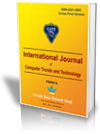Managing Latency Equalization Through Restored Routers
 | International Journal of Computer Trends and Technology (IJCTT) |  |
| © - April Issue 2013 by IJCTT Journal | ||
| Volume-4 Issue-4 | ||
| Year of Publication : 2013 | ||
| Authors : D.Nithya, G.Kalpana |

D.Nithya, G.Kalpana "Managing Latency Equalization Through Restored Routers"International Journal of Computer Trends and Technology (IJCTT),V4(4):816-818 April Issue 2013 .ISSN 2231-2803.www.ijcttjournal.org. Published by Seventh Sense Research Group.
Abstract: -We propose a Latency Equalization (LEQ) service, which equalizes the supposed latency for all clients participate in an interactive network application. To successfully apply the proposed LEQ service, network support is necessary. Our network-based LEQ service provides equalized-latency paths between the clients and servers by redirecting interactive application traffic from different clients along paths that minimize their delay difference. The LEQ architecture uses a few routers in the network as hubs to transmit packets of interactive applications along paths with similar end-to-end delay. We first formulate the hub selection difficulty, prove its NP-hardness, and provide a greedy algorithm to solve it. Through extensive simulations, we show that our LEQ architecture extensively reduce delay difference under different optimization criteria that allow or do not allow compromising the per-user end-to-end delay. Our LEQ service is incrementally deployable in today’s networks, requiring just software modifications to edge routers.
References-
[1]M.Yu, M. Thottan, and L. Li, “Latency equalization: A programmable routing service primitive,” in Proc. ACM PRESTO, 2008, pp. 39–44.
[2] J. Nichols and M. Claypool, “The effects of latency on online Madden NFL football,” in Proc. NOSSDAV, 2004, pp. 146–151.
[3] B. Fortz and M. Thorup, “Internet traffic engineering by optimizing OSPF weights,” in Proc.IEEE INFOCOM, 2000, vol. 2, pp. 519–528
[4] N. Spring, R. Mahajan, and D. Wetherall, “Measuring ISP topologieswithRocketfuel,” IEEE/ACM Trans. Netw., vol. 12, no. 1, pp. 2–16,Feb. 2004.
[5] R. Prasad, C. Dovrolis, andM. Thottan, “Router buffer sizing revisited:The role of the output/input capacity ratio,” in Proc. ACM CoNEXT,2007, Article no. 15.
[6] “Indiana University Global Research Network Operations Centerweather maps,” Global Research Network Operations Center, Indiana University, Indianapolis, IN [Online]. Available: http://weathermap.grnoc.iu.edu/
Keywords — pathcongestion,,pathfailure,pathlatency,routingmethodology,shortest path.
